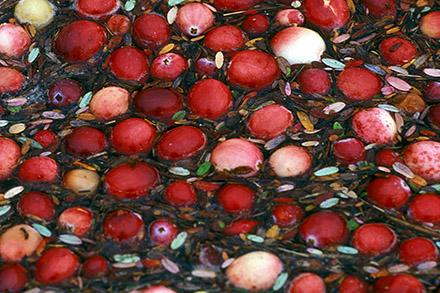A Green Alternative to Pesticides for Cranberry Growers
About 20 percent of the nation’s cranberries are consumed each year at Thanksgiving, and our appetite for them—in sauces, juices, and snacks—shows no signs of abating. So two ARS scientists are trying to ensure a sustainable future for the bright-red berries.
Shawn Steffan and David I. Shapiro Ilan are working to help cranberry growers tap into the potential of some new tools provided by nature, namely two nematode species native to Wisconsin that effectively control cranberry pests.
Cranberry growers use chemical insecticides to control the beetles and fruitworms that attack their crops, often spraying two or three times a year. The treatments cost up to $100 per acre, and many growers have several hundred acres of cranberries.
“Many cranberry growers are very interested in having new tools to control pests, especially tools that can reduce their use of pesticides,” says Steffan, who is with the Vegetable Crops Research Unit in Madison, Wisconsin.
He has discovered that a previously identified nematode he found in some Wisconsin soils, Oscheius onirici, offers tremendous potential as a biocontrol agent. It kills several major cranberry pests, including the dreaded red-headed flea beetle and the sparganothis fruitworm (a.k.a. Sparg), in less than 72 hours. He reported his findings in a 2018 paper in the Journal of Nematology. The nematode had been previously identified by researchers in Italy and has also been found in Oregon and France.
Steffan has been evaluating O. onirici and a second nematode species, Heterorhabditis georgiana, as potential biocontrols for 3 years. H. georgiana was originally discovered by Shapiro Ilan, an ARS entomologist with the Southeastern Fruit and Tree Nut Research Laboratory in Byron, Georgia.
Steffan has found that when they are applied to the soil and watered, O. onirici and H. georgiana appear to be just as effective at controlling cranberry pests as two insecticide applications. This could be good news in Wisconsin, where cranberries are a $1 billion industry. The state produces more than 60 percent of the nation’s supply, and the cranberry is Wisconsin’s official fruit.
Additional studies are planned, but preliminary results show that the two nematodes should be effective in cranberry production nationwide and could also be useful in controlling pests of blueberries and other crops, Steffan says.
They wouldn’t be the first nematodes used as biocontrols. Dozens of nematode species attack insect pests, and 12 different types of them are now used in commercial products to control thrips, citrus weevils, black vine weevils, borers, and other pests, according to Shapiro Ilan. “Most of these nematodes can kill a wide range of insect pests, but they won’t hurt plants, people, or the environment,” he says. They also do not pose a threat to ladybugs, honey bees, or other beneficial insects.
Steffan and Shapiro Ilan are developing an inexpensive, portable production system that cranberry growers could use to mass produce O. onirici and H. georgiana so they can apply them with the same equipment they now use to spray insecticides.
The efforts should mean less pesticide use in cranberry production, and they could open European markets to more U.S. cranberry producers.—By Dennis O’Brien, ARS Office of Communications.
You May Also Like


